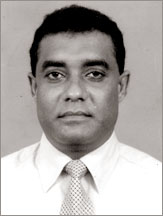South suffers sodium chloride deposits
by Afreeha Jawad
|

Dr. Ranjana U. K. Piyadasa
|
Following Tsunami's onslaught in December 2006 Southern Sri Lanka is
into heavy deposits of Sodium Chloride. As a result, electrical
conductivity in drinking water has gone upto 8,000 micro siemens per
centimetre exceeding even WHO's accepted levels of 1,000 micro siemens
per centimetre.
Aggravating the problem into a near beyond redemption state is the ad
hoc and haphazard digging of wells and ponds where the collapsing earth
along with water salinity causes twin damage. Should the status quo
continue, the intended social cost certainly will be irreversible.
"The sea water rushed inland with such force covering a distance of
about 2-3 kilometres. However, depending on the land formation,
elevation and vegetation the salinity varies in degrees from place to
place", said Dr. Ranjana U. K. Piyadasa, Hydro-geologist, Colombo
University when the Sunday Observer met him recently.
The sea water density being higher than fresh water, greater
complication sets in when the rivers were intruded with sea water that
heightened salinity levels. In between the rivers and the coastal belt
the situation remains unrectified.
 Nature helps fight the present crisis even though temporarily. For
instance high rainfall mitigates underground water salinity. The rain
that lashes on highland which water reaches the ground keeps a constant
flow enabling the cleansing of ground water salinity yet during the dry
season this process is halted impacting negatively into its
re-emergence. Nature helps fight the present crisis even though temporarily. For
instance high rainfall mitigates underground water salinity. The rain
that lashes on highland which water reaches the ground keeps a constant
flow enabling the cleansing of ground water salinity yet during the dry
season this process is halted impacting negatively into its
re-emergence.
However the coastal belt's flat land and river based areas continue
to record high salinity levels.
Listening to Dr. Ranjana Piyadasa this is certainly not a hopeless
situation provided professional assistance of scientists is sought. Some
organizations tried to clean the wells following the tsunami damaging
the interface between fresh and saline groundwater.
The interface believably nature's finest asset- a sort of protective
cover, in the process upcones resulting in sea water intruding fresh
water.
Thus the natural cleansing process of salinity through rain is
hindered in coastal and hilly areas.
Artificial groundwater re-charge like wells and ponds says Dr.
Ranjana Piyadasa is the best way out to reduce salinity in flat land,
yet calls for cleansing professional help. The rain water filled ponds
and wells help in salinity which method is popular even in European
countries and India - not necessarily following a tsunami.
Dr. Ranjana Piyadasa is the team head of a group comprising the
Colombo, Ruhuna and Kelaniya Universities studying hydrological
conditions and groundwater quality distribution in tsunami affected
south.
Studies pertaining to groundwater quality and water table behaviour
at Weligama Bay where ninety affected shallow dug wells situated on an 8
kilometre coastal strip reveal high levels of saline.
"The underground pressure wave which developed due to the tsunami may
have disturbed the fresh water - salt water equilibrium resulting in the
mixing of fresh ground water with saline water. Under natural conditions
and equilibrium exists between sea water and fresh water depending on
the geological and hydro-geological condition.
Due to the high density of sea water, it tends to force its way
underneath the fresh water.
However as the piezometric head of the fresh water is higher than sea
water, the fresh water continually discharges to the sea. Fresh water
discharges are opposite to the inland seawater movement whereby an
equilibrium exists.
Sea water that moves inland causes salt water intrusion. Once the
groundwater equilibrium is established, the water level will stabilise
and fluctuates only annually with seasonal changes and natural hazards,"
he said.
[email protected]
|
